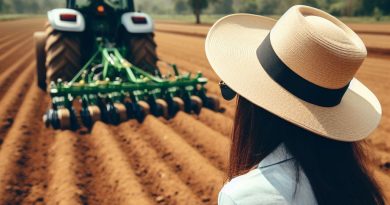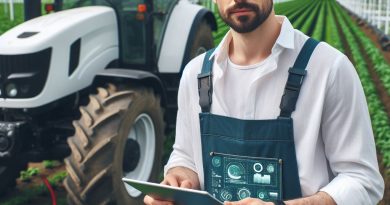Agri Robots: Revolutionizing Precision Agriculture
Last Updated on January 18, 2024
Introduction
In the dynamic realm of precision agriculture, technology plays a pivotal role in shaping the future of farming.
Introducing agri robots, innovative machines designed to revolutionize how farmers approach precision agriculture.
These robotic systems have the potential to enhance efficiency, reduce resource usage, and optimize crop yields.
As we delve into the intricate world of precision agriculture, the fusion of technology and agriculture takes center stage.
The significance of this integration cannot be overstated, offering solutions to challenges faced by traditional farming methods.
Agri robots emerge as a groundbreaking addition, promising transformative changes in the agricultural sector.
These robots, equipped with advanced technologies, bring automation to tasks such as planting, monitoring, and harvesting.
Their potential impact extends beyond operational efficiency, influencing factors like resource conservation, sustainability, and overall productivity.
As we navigate the landscape of precision agriculture, agri robots stand out as futuristic agents of change.
The combination of artificial intelligence, sensors, and robotics creates a powerful synergy that can redefine how farmers manage their fields.
The blog post explores the nuances of this technological revolution, unraveling the benefits and implications for precision agriculture.
As we embrace the era of agri robots, the agricultural sector stands poised for a transformative journey towards increased productivity, sustainability, and a technologically advanced future.
The concept of precision agriculture
Definition and explanation of precision agriculture
Precision agriculture refers to the practice of using technology and data analysis to optimize farming operations.
It involves collecting and analyzing data about soil conditions, weather patterns, crop health, and other factors.
The aim of precision agriculture is to make farming more efficient and sustainable by applying the right amount of inputs, such as fertilizers and pesticides, at the right time and in the right location.
Benefits of precision agriculture in terms of productivity and sustainability
- Increased productivity: Precision agriculture allows farmers to make data-driven decisions, leading to higher crop yields and improved overall productivity.
- Resource optimization: By precisely applying inputs, farmers can reduce waste and minimize the use of resources like water, fertilizers, and pesticides, making agriculture more sustainable.
- Cost savings: Precision agriculture helps farmers optimize their use of inputs, reducing unnecessary expenses and increasing profitability.
- Environmental impact: By using precision agriculture techniques, farmers can minimize the negative environmental impacts associated with conventional farming practices.
Role of technology in enabling precision agriculture
- Remote sensing: Technologies like drones and satellites provide real-time data on soil conditions, crop growth, and pest infestations, allowing farmers to make timely and accurate decisions.
- Geographic Information Systems (GIS): Farmers use GIS technology to craft detailed maps of their fields, enhancing comprehension of variations in soil fertility, moisture, and parameters.
- Sensor technology: Soil moisture sensors, weather stations, and various sensors furnish farmers with precise environmental information, aiding optimization of irrigation and resource management.
- Data analytics: Advanced analytics and machine learning algorithms analyze large volumes of data, providing insights on crop health, disease detection, and yield prediction.
Introduction to agri robots as a technological solution for precision farming
- Agri robots are robotic devices specifically designed for agricultural tasks, such as planting, harvesting, and monitoring crops.
- These robots can perform repetitive tasks more efficiently and accurately than humans, saving time and reducing labor costs.
- Agri robots are equipped with sensors, cameras, and other technologies that enable them to collect data and make autonomous decisions.
- They can operate 24/7, ensuring continuous monitoring and timely intervention in case of any issues.
- Agri robots have the potential to revolutionize precision agriculture by improving efficiency, reducing dependence on manual labor, and enabling precise application of inputs.
In short, precision agriculture is a modern farming approach that leverages technology to optimize productivity and sustainability.
With the help of technologies like remote sensing, GIS, sensors, and data analytics, farmers can make data-driven decisions and minimize resource waste.
Agri robots play a crucial role in this revolution, offering enhanced efficiency and precision in agricultural tasks.
As the agriculture industry continues to evolve, the integration of agri robots and other advanced technologies will significantly shape the future of farming.
Read: Smart Greenhouses: Tech Explained
Types of Agri Robots
Agri robots have transformed the agricultural landscape by revolutionizing precision agriculture.
These robots, equipped with advanced technologies and computer systems, assist farmers in various tasks, leading to increased productivity and efficiency.
In this section, we will discuss the different types of agri robots, their uses, and examples of their applications.
Unmanned aerial vehicles (UAVs) or drones
Uses and benefits of drones in precision agriculture
Drones have become increasingly prevalent in the field of precision agriculture.
Their ability to fly autonomously, collect high-resolution imagery, and perform specific tasks has made them invaluable tools for farmers.
They offer numerous benefits, such as cost-effectiveness, time-saving, and improved crop management.
When it comes to precision agriculture, drones are used for a variety of purposes.
They can monitor crop health by capturing aerial imagery, allowing farmers to identify areas that require attention, such as pest infestations or nutrient deficiencies.
Drones equipped with multispectral sensors can provide detailed information about crop conditions, helping farmers make informed decisions regarding irrigation and fertilization.
Overview of different types of agricultural drones
- Different types of agricultural drones are available to cater to specific requirements.
- Fixed-wing drones are suitable for large-scale operations and can cover extensive areas efficiently.
- Rotary-wing drones, on the other hand, have the advantage of vertical take-off and landing, making them ideal for small or irregularly shaped fields.
Examples of drone applications in crop
- The applications of drones in precision agriculture are vast.
- In crop monitoring, drones can quickly survey large areas, identifying anomalies and assisting in early pest and disease detection.
- Spraying drones equipped with precision spraying systems ensure targeted application of pesticides or fertilizers, minimizing waste and environmental impact.
- Mapping drones create accurate field maps, aiding in better planning and resource allocation.
Autonomous ground vehicles
Advantages of autonomous ground vehicles in precision agriculture
- Autonomous ground vehicles have emerged as important tools in precision agriculture.
- Their self-driving capabilities and specialized features make them valuable assets on the farm.
- These vehicles offer advantages such as reduced labor costs, increased efficiency, and improved data collection.
Examples of ground vehicle applications in field scouting, planting, and harvesting
- In precision agriculture, autonomous ground vehicles are used for various tasks.
- Field scouting is one application where these vehicles are equipped with sensors to collect data on soil moisture, temperature, and crop health.
- Planting operations can be optimized by autonomous seeders that ensure consistent spacing and depth, leading to better crop establishment.
- Harvesting is another area where autonomous vehicles prove beneficial, as they can efficiently and accurately pick ripe produce, minimizing losses and reducing manual labor.
Overview of different types of autonomous ground vehicles
- Different types of autonomous ground vehicles are available to meet specific needs.
- Tractors equipped with autonomous systems can perform tasks such as plowing, cultivating, or spraying with precision.
- Robots designed for selective harvesting work alongside humans, reducing the physical strain and increasing harvesting speed.
Robotic arms and manipulators
Importance of robotic arms in precision agriculture
- Robotic arms and manipulators offer precise and efficient solutions for various agricultural tasks.
- From delicate fruit picking to complex pruning techniques, these robotic systems assist in improving productivity and reducing human labor.
- The importance of robotic arms in precision agriculture cannot be overstated.
- They provide consistent and precise movements, ensuring accurate tasks like fruit picking or pruning.
- Robotic arms equipped with computer vision systems can identify ripe fruit and pick them gently, minimizing damage.
- In the packing process, these arms can automate the sorting and packaging of produce, streamlining the post-harvest operations.
Overview of different types of robotic arms and manipulators
- Different types of robotic arms and manipulators cater to specific agricultural needs.
- Parallel robots excel at high-speed operations, making them suitable for fruit picking.
- Articulated robotic arms offer flexibility and range of motion, making them ideal for tasks like pruning or complex manipulations.
- Each type of robotic arm contributes to increased efficiency and reduced labor costs in precision agriculture.
In summary, agri robots encompass a wide range of technologies that enable precision agriculture.
Unmanned aerial vehicles or drones provide valuable insights into crop health and assist in crop monitoring and spraying operations.
Autonomous ground vehicles optimize field scouting, planting, and harvesting processes.
Robotic arms and manipulators improve fruit picking, pruning, and packing tasks.
The integration of these agri robots revolutionizes the way farmers approach agriculture, leading to increased productivity, sustainability, and profitability.
Read: Future of Farming: Drone Technology

Benefits of Agri Robots in Precision Agriculture
Agri robots play a crucial role in revolutionizing precision agriculture by offering numerous benefits to farmers and the environment.
By utilizing these robots, farmers can experience increased efficiency and productivity in their daily operations.
Increased efficiency and productivity
- Automation of repetitive tasks: One of the significant advantages of agri robots is their ability to automate repetitive tasks.
This feature allows farmers to save time and effort, enabling them to focus on more complex activities that require their expertise and attention.
With the help of agri robots, farmers can streamline their operations and achieve higher productivity levels. - Quick and accurate data collection: Another benefit is the quick and accurate data collection provided by agri robots.
These robots are equipped with advanced sensors and imaging technology, allowing them to gather valuable data about various factors influencing crop growth and health.
The collected data provides farmers with crucial insights, enabling them to make informed decisions regarding irrigation, fertilization, and pest control. - Timely and precise execution of farming activities: Moreover, agri robots ensure the timely and precise execution of farming activities.
For example, robots can plant seeds and apply fertilizers in optimal quantities, as per the specific requirements of each crop.
Similarly, during harvesting, agri robots can efficiently collect ripe crops without damaging them.
This precision in farming activities contributes to better crop yield and overall farm profitability.
Reduction in resource consumption
- Optimal utilization of water, fertilizers, and pesticides: Agri robots enable optimal utilization of water, fertilizers, and pesticides, reducing waste.
- Lower energy usage due to automated processes: Automated processes in precision agriculture result in lower energy usage, contributing to resource conservation.
- Minimized waste and environmental impact: By minimizing waste and environmental impact, agri robots promote sustainable farming practices.
Improving crop health and yield
- Crop monitoring and disease detection are enhanced through the use of agri robots.
- Precision application of treatments and interventions based on real-time data leads to healthier crops.
- Intelligent decision-making, driven by the analysis of data collected by robots, improves overall crop yield.
- Furthermore, agri robots enable intelligent decision-making based on real-time data.
- The data collected by these robots, along with advanced analytics, provides farmers with valuable insights into crop performance and environmental conditions.
- By analyzing this data, farmers can make informed decisions about adjusting cultivation practices, optimizing resource utilization, and mitigating risks.
- This data-driven decision-making results in improved crop yield and financial outcomes for farmers.
In general, agri robots offer significant benefits in precision agriculture.
These robots contribute to increased efficiency and productivity through automation, enable better resource management, and enhance crop health and yield.
By embracing agri robots, farmers can embrace sustainable and profitable farming practices while meeting the growing demand for food production.
Read: AI in Agriculture: A 2024 Overview
Challenges and limitations of agri robots
High initial investment and maintenance costs
- Agri robots require significant capital investment for purchase and ongoing maintenance.
- Farmers may face financial barriers when considering the adoption of agri robots.
Compatibility issues with existing farming infrastructure and practices
- Integrating agri robots with existing farm infrastructure and practices can be challenging.
- Older farming equipment may not be compatible with the technology required for agri robots.
Limited capabilities and adaptability in complex farming environments
Agri robots may struggle to perform efficiently in complex and dynamic farming environments.
Concerns about data privacy, cybersecurity, and potential job displacement
- The use of agri robots involves collecting and analyzing vast amounts of data.
- Farmers and stakeholders may have concerns about the privacy and security of this data.
- Cybersecurity threats loom, as hackers could gain access to sensitive farm information.
In a nutshell, while agri robots offer numerous advantages in precision agriculture, they also face a range of challenges and limitations.
High initial and maintenance costs, compatibility issues, limited capabilities, and concerns about data privacy and job displacement challenge agri robot adoption.
Overcoming these challenges will require ongoing research and development to improve the affordability, compatibility, adaptability, and security of agri robots.
Agri robots have the potential to revolutionize precision agriculture, promising increased efficiency, productivity, and sustainability despite current limitations.
Read: Hydroponics 101: Basics & Benefits
Current Developments and Future Prospects of Agri Robots
Overview of Major Companies and Startups in Agri Robot Development
- Abundant Robotics: A California-based company that develops apple-picking robots to increase productivity and reduce labor costs.
- Blue River Technology: Known for their lettuce thinning robot, which uses computer vision to identify and eliminate unwanted plants.
- Harvest Automation: Focuses on the development of robots to handle repetitive tasks in nurseries and greenhouses.
- John Deere: A leading agricultural machinery manufacturer that has recently ventured into agri robot development.
- Small Robot Company: A UK startup working on developing autonomous robots for precision farming.
Advances in Artificial Intelligence and Machine Learning for Better Automation
- AI algorithms enable agri robots to perform complex tasks like weed detection and crop monitoring.
- Machine learning algorithms improve robot learning capabilities, allowing them to adapt to various farming conditions.
- AI-powered robots can collect and analyze large amounts of data to optimize farming practices for higher crop yields.
- Advanced computer vision systems in robots help identify pests, diseases, and nutrient deficiencies in crops.
Integration of Agri Robots with Other Technologies like Sensors and IoT Devices
- Agri robots can be integrated with sensors to provide real-time data on soil moisture, temperature, and nutrient levels.
- IoT devices allow farmers to remotely monitor and control agri robots, enabling efficient resource management.
- Combined with satellite imagery and weather forecasts, agri robots can make data-driven decisions for precision agriculture.
- Integration with farm management software systems helps automate tasks and streamline operations.
Potential Growth and Adoption of Agri Robots in the Near Future
- The market for agri robots is expected to grow significantly, driven by factors such as labor scarcity and the need for increased efficiency.
- Adoption of agri robots can lead to reduced costs, improved crop quality, and minimized environmental impact.
- As the technology advances and becomes more affordable, smaller farms can also benefit from adopting agri robots.
- Governments and research institutions are investing in agri robot development to address agricultural challenges and improve farming techniques.
- Increased collaboration between agri robot companies and farmers will play a crucial role in accelerating adoption and driving innovation.
Overall, Major companies and startups drive agri robot technology, integrating AI, machine learning, and other advancements, signaling a bright future for precision agriculture.
Agri robots have the potential to revolutionize farming practices, improve productivity, and ensure sustainable food production in the face of increasing challenges.
Conclusion
Precision agriculture’s significance lies in its transformative impact on farming practices, fostering sustainability, and enhancing yields.
Agri robots, as revolutionary technological entities, hold promise for optimizing efficiency and overcoming agricultural challenges.
The benefits of these robots include increased productivity, resource conservation, and operational streamlining.
However, challenges such as high initial costs and technological dependencies must be navigated.
Despite these challenges, the potential revolution introduced by agri robots in precision agriculture is undeniable.
As we recap the importance of precision agriculture, the role of technology, particularly agri robots, stands out.
These robots have the capacity to revolutionize farming by introducing automation, data-driven decision-making, and efficient resource management.
The journey towards a more sustainable, productive, and tech-driven agricultural future is propelled by the integration of agri robots into precision agriculture practices.
The potential revolution brought by agri robots heralds a new era in farming—one where technology and innovation converge to shape the future of precision agriculture.
The transformative impact of these robots promises not only increased yields but also a more sustainable and efficient approach to cultivating the land.
As we embrace this technological evolution, the landscape of precision agriculture is destined for a future where agri robots play a central role in redefining how we cultivate and harvest our crops.


